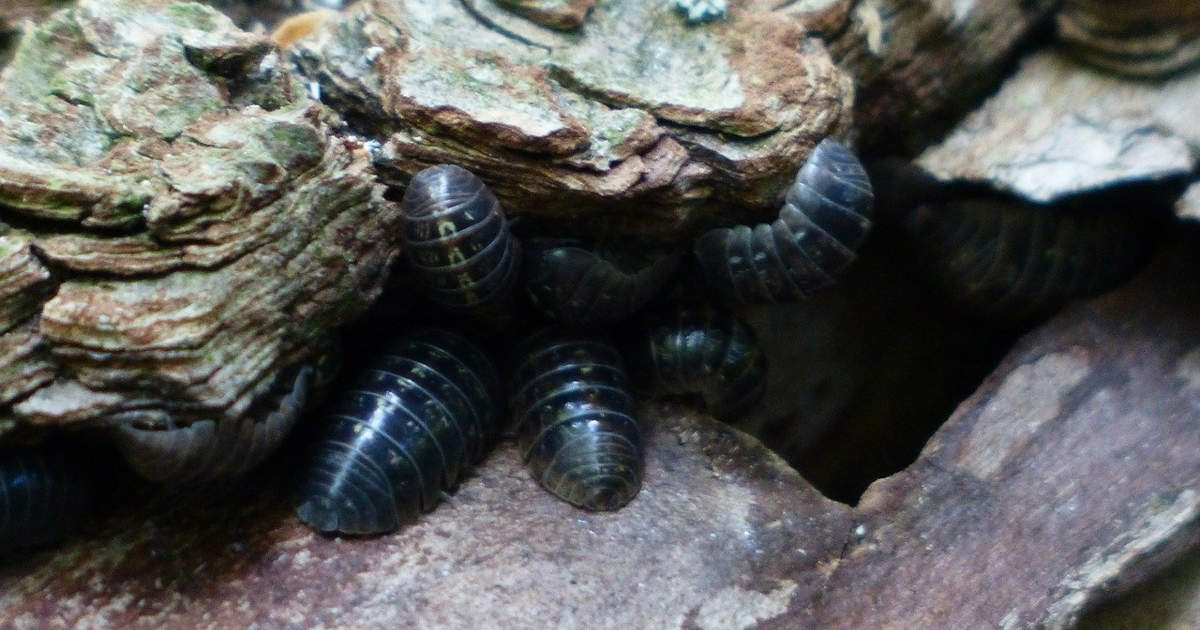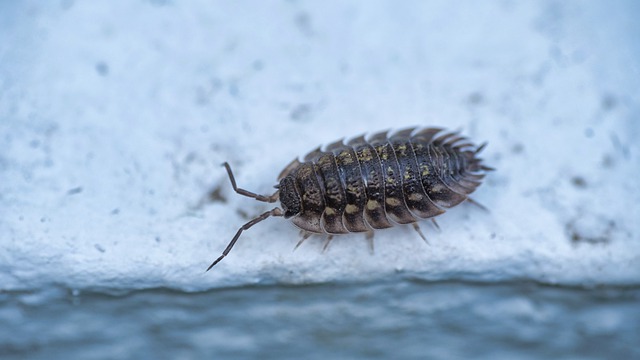Can Bearded Dragons Eat Isopods?
In this post we learn that bearded dragons can eat isopods – as well as what isopods are and why they might be in your bearded dragon’s tank

Last Updated: March 20th, 2022
By: Steve
Table of Contents
What Are Isopods?
Isopods are crustaceans and can live in water environments or on land (although each species lives either in water or on land – not both). The isopod with which you are most likely to be familiar is the Woodlouse, sometimes known as the ‘rolly pollie’ pictured below. In this post we’ll discover that bearded dragons can eat isopods, and when and why that might happen.

Isopods have 7 pairs of limbs, a chitinous exoskeleton and two pairs of antennae. They have various forms of feeding, some eating meat while others eat decaying vegetation. Some others are parasitic in nature (though usually of fish).
The most likely isopods for bearded dragons will be the land dwelling, decaying vegetation feeding versions – such as the woodlouse pictured above. They live in moist places, under bark or leaves usually where it’s a bit cooler and their desired food is plentiful.
Interestingly perhaps, in the wild, isopods will make up a good proportion of their insect diet since the bearded dragons live in areas where there is lots of leaf litter and dropped branches from bushes and the occasional tree.
Benefits of Isopods for Bearded Dragons
The biggest benefit of isopods for bearded dragons will be seen in a ‘bioactive’ vivarium. A bioactive vivarium is one where the substrate (flooring) used isn’t solid, such as tiles are. In a bioactive environment the substrate is made up of specific soil, leaf and wood materials.
Bioactive vivariums are becoming more popular and there’s certainly some good reasons for them. They’re closer to the bearded dragons natural habitat than the more ‘sterile’ setting of solid substrate such as tiles or carpet and soft fluffy furniture.
However, they’re not for everyone and they do take a lot more setting up and balancing than the more normal setup for bearded dragons.
The video below by ‘The Bio Dude’ on YouTube gives you a bit of an introduction into the world of bioactive vivariums for bearded dragons – which is where you’ll find the most likely use of isopods.
Isopods Help With Soil Aeration
In the bioactive vivarium, the isopods will help with soil aeration as they burrow through and around it. They’ll create tiny tunnels through it allowing air to pass around roots of any plants and helping keeping them healthy. As part of the same process they turn the soil over in a similar way to farmers would ’till’ the land. This all helps release nutrients into the soil allowing plants to thrive.
They Can Help With Nutrient Distribution
As we mentioned above, the tilling of the soil helps to release nutrients into the soil, but the isopods also help to move the nutrients around and indeed create new nutrients from the old decaying leaves and branches. They do this because as they eat the decaying solid matter, they turn it into isopod poop which they distribute further throughout the soil. This is all good nutrients for plants in the soil.
Isopods Help Keep Mites and Pest Eggs Down
Some of the isopods recommended for bioactive vivariums will also eat the small eggs of pests and mites that might be in the vivarium substrate. This helps to reduce the amount of pests in the environment for your bearded dragon and makes the ecosystem much safer for your bearded dragon without the need for any pesticide sprays.
Are Isopods Good For Bearded Dragons If They Eat Them?
Of course, all the above is very nice and very good if you have a bioactive vivarium. But what happens if your bearded dragon eats the isopods that are supposed to be cleaning the environment. Are these isopods harmful to your bearded dragon or can they safely eat them?
There’s really not much nutritional information available for isopods for feeding bearded dragons. However, the isopods that you will find for bioactive vivariums are perfectly safe for your bearded dragon to eat now and then. Indeed, as we mentioned above, these creatures will form a decent proportion of their natural diet.
Nevertheless, you’re better off actively feeding your bearded dragon on any of the cultivated insects such as locusts, dubia roaches or crickets or other insects for bearded dragons. This is because little is known about the nutritional qualities of the isopods – and the isopods are there to do a job rather than be food.
It’s also perhaps worth noting that isopods have a fairly hard chitinous exoskeleton. They are generally quite small, so won’t pose a problem for adult bearded dragons, but might cause a choking or impaction hazard for baby bearded dragons if they eat too many.
So, we wouldn’t recommend actively feeding isopods to bearded dragons, but if they eat some from within their bioactive vivarium it won’t do them any harm.
Which Isopods Are Best In A Bearded Dragon Tank
According to the Bio Dude, the best isopods for a bearded dragon tank are the Powder Orange and Powder Blue (Porcellionides pruinosus) variety, although being slightly larger than some others, they might find themselves becoming bearded dragon feed. They break down faeces and other organic matter quickly, recycling it into the soil for the plants in your bioactive setup.
Other recommended isopods are;
- Dairy Cow (Porcellio laevis)
- Dwarf Purple (Trichoniscidae sp.)
- Dwarf White (Trichorhina tomentosa)
- Giant Canyon (Porcellio dilatatus)
- Orange (Porcellio scaber)
- Zebra (Armadillidium maculatum)
It’s also worth noting that Morioworms can also be used in a bioactive environment – and bearded dragons can definitely eat superworms (Zophobas Morio).
What About Moisture Content for Isopods?
Bearded dragons require quite a dry environment and low humidity doesn’t normally mix well with isopods who like a moist environment in which to live. Bearded dragons need a low humidity in their tank to help reduce the risk of diseases such as respiratory infections and fungal infections.
But a bioactive environment is, by nature, going to need a more humid environment. For this reason it’s important to get advice on setting up a bioactive environment specifically for bearded dragons. The video linked above is a great starting point and Josh has been doing this for years.
The most important point though is that the dried leaf content on the floor of the environment is an important factor in separating the moist, cool soil in which the isopods will live from the dry and warm air temperature of the bearded dragon tank.
It’s going to be a delicate balance that you’ll need to maintain and you’ll certainly need hygrometers amongst the equipment required for your bearded dragon to measure the humidity in the air in the tank.
Summary
In this post we’ve learned that bearded dragons can eat isopods, including woodlice as well as others. The most common reason for bearded dragons to eat isopods would be when the bearded dragon environment is a ‘bioactive’ vivarium whereby the soil grows plants within it and contains small insects or isopods as cleanup agents.
Although we’ve not gone into a great deal of depth about bioactive vivariums in this post, we have linked to an authority on the subject on YouTube if you would like more information about bioactive setups.
Isopods aren’t commonly fed in traditional bearded dragon vivariums and little is know about their actual nutritional content – even though they’d eat these creatures commonly in the wild. But then again, bearded dragons don’t generally live that long in the wild so what they do in the wild isn’t necessarily a good gauge for what they should do in captivity!
If you’ve enjoyed this post please feel free to share it with your friends using the buttons below. If you have any questions, comments or other feedback please use the form below to let us know – we’d love to hear from you!
Thanks for reading!
Featured Image by Hans Braxmeier from Pixabay
